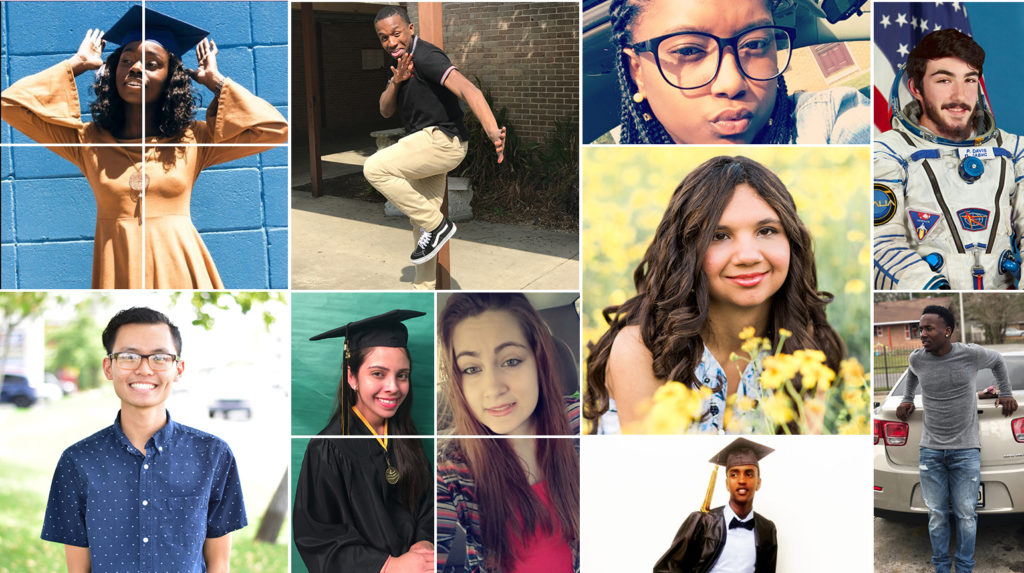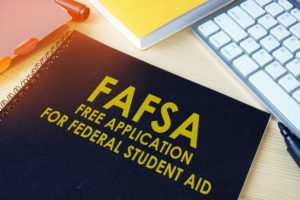
Unlocking Support for College
Unlocking Support for College
Young people who simply file a free college financial aid form are more likely to go on to college and pursue their educational dreams. Through an innovative partnership funded by the Kresge Foundation, more low-income students are getting the encouragement they need.
When it comes to getting more low-income students to consider pursuing college, one of the most successful strategies is a surprisingly simple one: ensuring that they file a FAFSA.
The Free Application for Federal Student Aid, or FAFSA for short, is a form students file annually if they want to receive any kind of federal funding, including Pell grants and government-backed loans, as well as some state scholarships and work-study programs.
Students who file the FAFSA are 63 percent more likely to attend college, reports the National College Access Network. Yet just 61 percent of the high school class of 2017 applied for federal aid. The reasons are varied, and include burdensome red tape, the absence of support from school counselors or parents, and general lack of awareness about eligibility and the valuable potential benefits.
We at The Kresge Foundation feel strongly that a bureaucratic form shouldn’t stand in the way of a college student and his or her dreams. That’s why we have zeroed in on it.
When students file a FAFSA, not only do they unlock a piece of the billions of dollars in funds that might be available to them, but they take that first step that makes college real. They begin to identify – often for the first time — as someone who has college aspirations, who is on the college-going path. This can catalyze important conversations between themselves and their parents or caregivers about the value of college and what’s affordable for their family.
In short, FAFSA is powerful. But it needs to reach more students. More than $2 billion in federal funding has been left on the table in recent years, according to NerdWallet, because students just don’t file the form.
To help boost those numbers, and to strengthen what we at Kresge call “urban higher education ecosystems,” the Foundation made a $1.6 million grant in 2016 to launch the FAFSA Completion Challenge. We invited 118 cities across the country to tell us how they might go about increasing FAFSA completion rates by at least 5 percentage points for the graduating high school class of 2017. An advisory committee chose 22 cities to participate from a pool of 68 applicants. Each city selected received up to $55,000 through the National College Access Network, which administered and implemented the Challenge.
At Kresge, we've invested in FAFSA completion because it’s an important step toward improving college opportunity for all students.
The timing was right. We wanted to help cities gain momentum in a year when there were two major policy changes related to the form. Under the Obama administration, the opening date to file FAFSA was moved up from January to the previous October, ensuring students can find out what kind of financial support they will have earlier in the college decision-making process. The administration also in 2016 approved the use of what’s called “prior-prior year tax data,” which meant families could file their forms using tax data already available. The idea was to offer timely support to urban areas across the nation during a time of policy change.
For each of our 22 participating cities, the approaches differed in ways that fit their local context and cast of stakeholders, but trends also emerged. Altogether, the 22 cities combined to raise FAFSA completion rates by 4.7 percentage points and to help reverse a four-year decline in nationwide FAFSA completions – an impressive feat considering their urban settings, which face unique challenges in successfully reaching all student populations.

Students who benefited from the FAFSA Completion Challenge and secured financial aid to attend college. Photo credits: The Kresge Foundation
Those helped in the Challenge included students facing significant barriers to college – foster youth, students with vexing immigration issues, and even students who had battled homelessness. In Cheyenne, Wyoming, a student named Karina, who had endured homelessness as well as substance abuse issues, received guidance and support from a school counselor. She filed a FAFSA with the counselor’s help and wound up receiving enough money to enroll in Laramie Community College, where she is pursuing a nursing degree.
“When I saw I was eligible for enough money to pay for school, I was like, this is my purpose,” said Karina, whose story is one of 22 from the cities featured on our website at FAFSAstories.org. “I want to be successful so I can help myself and my mom. I want to be successful enough to help other people.”
Measuring Impact
Karina was one of thousands who filed a FAFSA in part because of the Challenge. To understand the full impact of the grant, we hired consulting firm Higher Ed Insight to evaluate the program in 2017 and to offer lessons to the field.
Through that evaluation, we found that neither informational campaigns nor large-scale FAFSA-completion events alone are sufficient to reach many low-income students. For these students, one-on-one outreach and support, albeit a hefty investment in time and resources, is needed to successfully navigate the college admissions process. And for participating cities, this individualized support was crucial to increasing FAFSA completions.

In addition, many of the Challenge cities said high schools played a central role in increasing FAFSA-completion rates. This underscored how critical it is for the K-12 sector to take a leading role in helping high school seniors complete the FAFSA through school-based events. The efforts of other partners are undoubtedly important, but without high school participation and engagement, cities are unlikely to boost FAFSA completions.
Finally, the use of data on FAFSA completion by high school seniors was crucial to setting goals and tracking progress toward those goals. Data was paramount to most of these projects and proved to be highly useful both for understanding what was happening with FAFSA completions in each city and for encouraging accountability on the part of school districts and high schools.
Eight of the cities that participated won prizes of $25,000 or more due to their successful efforts. Some of the highlights of what the cities accomplished included:
- 10 of the participating cities saw completion rates increase by more than 6 percentage points.
- Four cities—Greensboro, North Carolina; Charleston, West Virginia; Columbus, Ohio; and Los Angeles— achieved FAFSA completion rates above 66 percent—significantly better than the national rate for high school seniors of 56 percent in 2016 and 61 percent in 2017.
- The average increase in FAFSA completion rates for small cities in the competition was 9.6 percentage points compared to 3.7 percentage points for both medium and large cities. Unsurprisingly, it can be easier to move the needle more quickly in smaller markets.
Building on Results
The work of these Challenge cities offered lessons for others interested in improving FAFSA outcomes as a vehicle for better rates of college attendance. Here are a few of them.
For communities:
- Engage and support a cadre of individuals who can undertake the time-intensive, one-on-one support required to help students navigate the FAFSA process.
- Learn what high schools already do to engage students on the FAFSA, what challenges they face, and what resources or training they need to expand their support for students during the financial aid process.
- Work with state and school district partners to expand access to student-level FAFSA-completion data and to assist counselors and college access professionals in using the data.
For funders:
- Develop grant programs tailored to specific strategies that seem to be particularly central to increasing FAFSA completion rates, such as using FAFSA-completion data (both high school and student level) to develop goals and identify target populations, offering training and capacity-building opportunities for school counselors and front-line college access professionals, or supporting near-peer mentors.
- Require grantees to include sustainability plans in their proposals and encourage them to focus grant funding on sustainable uses, including developing reusable tools and resources and offering technical assistance with the expectation that partner organizations will take ownership of project activities after the grant ends.
At Kresge, we have invested in FAFSA completion because it’s an important step toward improving college opportunity for all students. Investments that lead to better FAFSA coordination, communication and expanded efforts, especially those that engage the business and public sectors, can make an immediate on-the-ground difference and ultimately, help more low-income students attend college and achieve their education dreams.
Caroline Altman Smith is deputy director of The Kresge Foundation’s Education Program.


